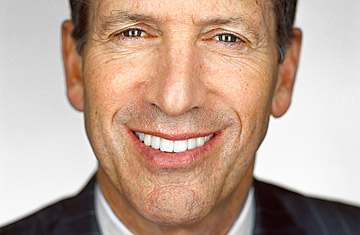
Starbucks CEO Howard Schultz
(2 of 3)
If there's one thing he's familiar with, it's redefinition and reinvention. In the midst of the recession, with its numbers going south and facing a round of unprecedented layoffs at its Seattle headquarters, Starbucks gathered its store managers for a meeting in New Orleans, where Schultz, who had been reinstalled as CEO that year, plotted a turnaround. There he had a revelation: he had to let the managers know just how badly things were going. "The question is, At a time like this, what do you share?" he says. Everything was his answer.
The solution came as a three-part strategy. The first part was basic economics. Starbucks had to bring more value to recession-hit customers in the form of more for their money and improved loyalty programs.
The second prong was technological. Starbucks is practically corporate HQ for the Facebook generation--you know those Occupy Starbucks people who sit at the tables for hours, working their laptops. It made perfect sense to use digital and social platforms to reach them. Starbucks had already used its website to mine customers for product ideas and let them share their experiences. As social and mobile grew, the company dived in, creating what Schultz called "world-class capability" that gave it a high standing on Facebook and Twitter in less than a year.
The message wasn't a hard sell but more like an open door. Starbucks has some 30.5 million Facebook followers--a massive constituency for a retailer--allowing it to dispense with lots of traditional advertising. Those Web-engaged customers pushed the company into accepting mobile payments, quickly making Starbucks a top retailer in that category. Customers use their phones in an average of 1 million transactions per week at Starbucks. These buyers are likely to be younger too, a coveted commodity because people tend to stick to their beverage preferences over a lifetime.
At the same time, Starbucks stopped opening up stores everywhere for growth's sake--growth that hid underperformance elsewhere. Instead it expanded only where the economics made sense. As a result, stores opened in the past 18 months are the best-performing in the company's history.
Caffeine Constituency
Schultz contends that because customers buy the company's values along with its java, they have given it license to venture beyond the traditional corporate mission--and that these efforts will actually support Starbucks' growth as well as bolster American employment. Create Jobs for USA works with the Opportunity Finance Network (OFN), a group of community lenders that makes grants to create jobs in poor communities in everything from child care to charter schools to small businesses. So far, Starbucks has raised over $10 million for the effort, including a $5 million donation from the Starbucks Foundation. OFN president Mark Pinsky says it takes about $21,000 to create and retain each new job; each $3,000 that Starbucks raises eventually creates a job. According to the company, the campaign has added at least 3,500 jobs across the country.
